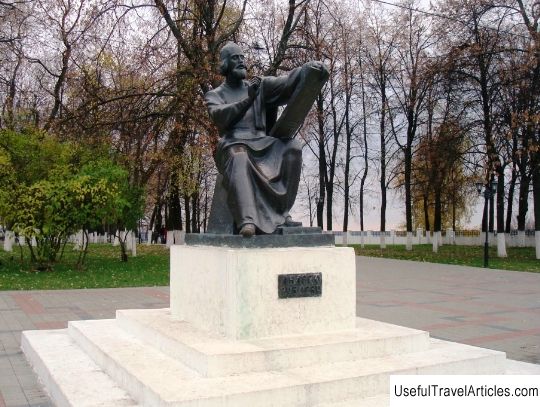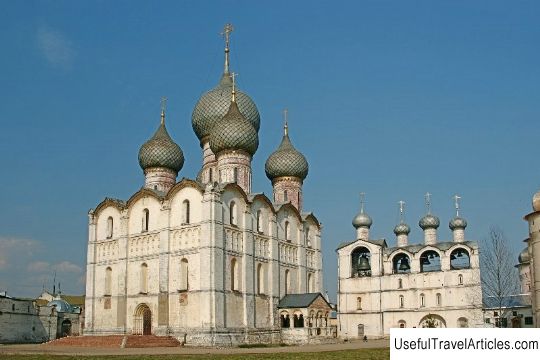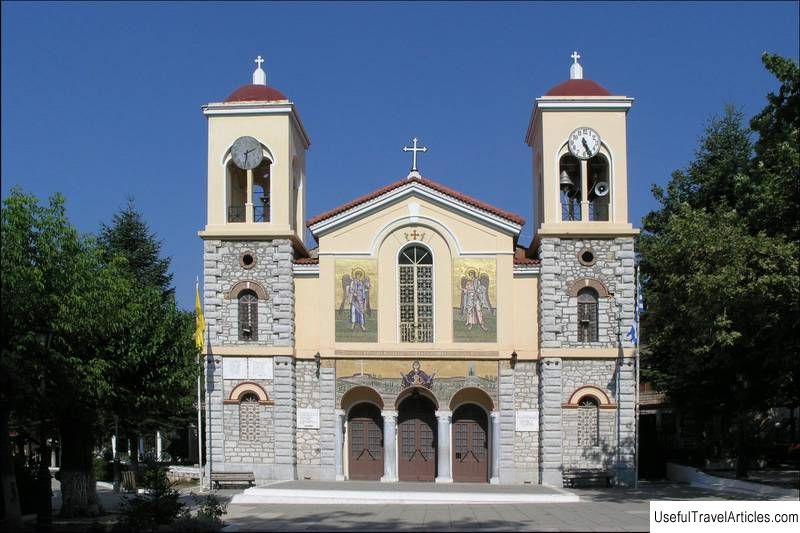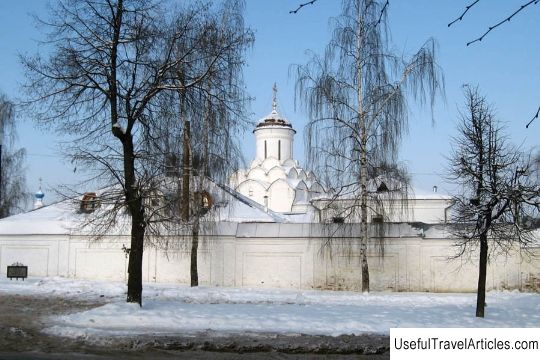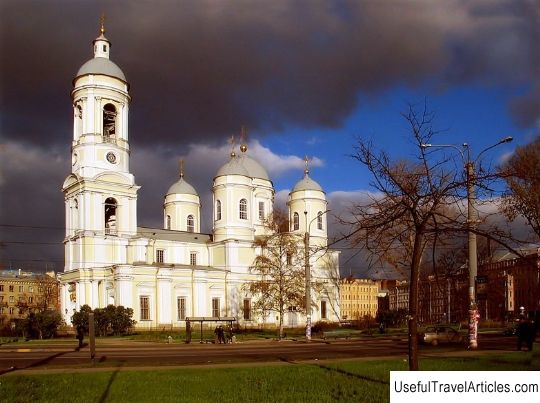Assumption Cathedral description and photos - Russia - Golden Ring: Vladimir
Rating: 7,8/10 (234 votes) 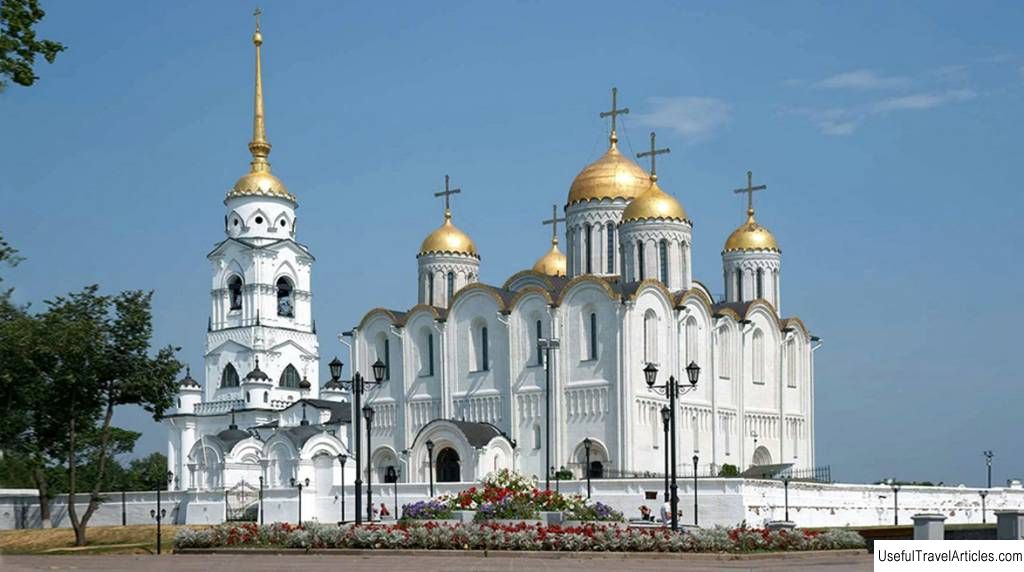
Assumption Cathedral description and photos - Russia - Golden Ring: Vladimir. Detailed information about the attraction. Description, photos and a map showing the nearest significant objects. Photo and descriptionThe Assumption Cathedral in Vladimir is included in the UNESCO World Heritage List. This is a unique monument of pre-Mongol architecture, in which frescoes by Andrey Rublev and Daniil Cherny have been preserved. History of the templeThe Assumption Cathedral was built in 1158-1560 Prince Andrey Bogolyubsky made Vladimir his capital and began a new pompous construction in it. The best masters were invited - according to some information, some of them were sent by Friedrich Barbarossa himself. The new temple was higher than the famous Kiev and Novgorod Sofia. In 1185, there was a fire that destroyed part of the murals and the temple was renovated and altered. This happened under the next prince - Vsevolod the Big Nest , younger brother of Andrey. It was under him that the Vladimir principality became the largest and most powerful of the Russian lands, and the Assumption Cathedral was its main temple and the burial vault of the rulers: Andrei Bogolyubsky, and his sons, and Vsevolod himself were buried there. During these years, the Assumption Cathedral was surrounded by wide closed galleries, and arches were made in the old walls - it turned out that the old temple was, as it were, inside the new one. Some of the carvings were transferred to the new outer walls, some were re-done. Scientists argue about whether the original temple was five-domed or one-domed, but the new temple definitely already had five chapters. In 1238, the cathedral was burning during the assault of Vladimir by the Tatar-Mongol troops , but only the interior was badly damaged, and the external appearance remained unchanged. In the XIV century at Dmitry Donskoy he re-signs the team of Andrey Rublev and Daniil Cherny . By the 18th century, the building was badly dilapidated. At the beginning of the 18th century, the roof of the cathedral was rebuilt - it was replaced by the usual hipped roof. But his condition still leaves much to be desired. In 1769, Catherine II visited Vladimir. She allocated 14 thousand rubles for the repair of the ancient temple. In the course of this repair, the old Rublev frescoes were whitewashed and the iconostasis was dismantled. Instead of the old one, a carved baroque style was installed in the spirit of the new era. It was cut by craftsmen Kalistrat and Stepan Bochkarevs . New icons were also placed in it - the works of the Vladimir icon painter Strokin . At the very beginning of the 19th century, earthen ramparts the old fortress, and the temple was surrounded by a new fence. In 1810, a new bell tower was built to replace the old one, which had been hit by lightning. The bell tower was built in the style of classicism, but made in such a way as to fit into the general ensemble - for example, its plaster decorations partly repeat the white stone carvings of the temple. A chapel was built on the ground floor of the bell tower. In 1862, according to the project of N. Artleben, the warm chapel of St. George the Victorious was rebuilt - now it connects the temple and the bell tower. During these years, the discovery of the ancient frescoes of the cathedral gradually begins. Cathedral in the XX-XXI centuries Since 1917 the famous Sergiy Stargorodky has served here, future patriarch. He was appointed Metropolitan of Vladimir in 1917, accepted Renovationism in 1922, and then renounced it. The next Archbishop of Vladimir - Nikolai Dobronravov - served here from 1923 to 1925, and in 1937 he was shot at the Butovo training ground. Now revered as a saint. In memory of him, a commemorative plaque was installed on the St. George's side-altar of the church. In 1922-23, all valuables were confiscated, and a branch of the museum was set up in the St. George's side-altar. At first it is the Museum of Church Antiquities , then - the Anti-Religious Department of the Vladimir Museum. In the pre-war and war years, the temple was practically abandoned for some time and no one cares for the unique frescoes. But in 1944 the temple reopens and it is a little tidied up both outside and inside. In the 50s, at the same time, a new heating system was installed in the building, which normalizes the temperature regime. The last restoration was carried out in 1974-82. At the same time, the burials in niches with inscriptions were restored. In 1995, a monument to Andrei Rublev by sculptor O. Komov appeared at the western wall of the temple, and in the early 2000s - a veneration cross in front of the temple and a memorial sign to the 600th anniversary of the Vladimir diocese. Now the temple acts as a cathedral. Vladimir saints The history of the Assumption Cathedral is associated with the tragic events of 1238, when Vladimir was ravaged by the Tatar-Mongol troops, and the Prince of Vladimir himself was killed Yuri Vsevolodovich , and his entire family, except for one daughter. Prince Yuri was killed in the battle on the river City or Seti. The youngest son of Yuri Vsevolodovich, Vladimir was captured. The Tatars offered to surrender the city in exchange for his life, but the defenders refused, and then Vladimir was executed at the Golden Gate. The Ipatiev Chronicle says that when it became clear that the city could not be saved, two other brothers - young Vsevolod and Mstislav - took monastic vows and went to negotiations, but were brutally killed. During the last assault on Vladimir, Princess Agafya Vsevolodovna , with her daughters, grandson and daughters-in-law, and Vladimir Bishop Mitrofan locked themselves in the Assumption Church. All of them prepared for death and took monastic form. The Tatars set fire to the temple, and everyone who took refuge in it died. All of them were buried right there, in the Assumption Cathedral, after it was repaired. In 1645, the body of Yuri Vsevolodovich was found incorrupt, and in the same year he and his family were canonized . In 1702, Andrey Bogolyubsky was also canonized. After the revolution, the relics were opened, examined and placed in the St. George Chapel as part of the museum exhibition. The body of Andrey Bogolyubsky was examined for many years, and it was transferred to the Church only in 1987. Another saint is the son of Andrei Bogolyubsky Gleb . Chronicle information about him has not survived, there are only hagiographic information. He died before he was twenty, shortly before the death of his father, and during his lifetime he was distinguished by piety and meekness and was very loved among the people. He began to be revered as a locally revered saint from the beginning of the 17th century - it is believed that in 1608 the city was delivered from the Lithuanian invasion precisely because of prayer to him. In 1702, his body was found incorrupt - and he was canonized together with his father. Not only princes, but also bishops were buried in the cathedral. Saint Mitrofan , who at the very beginning of the XIV century made Vladimir the center of the Russian metropolis. Now the burials are the main shrine of the cathedral. Frescoes of the Assumption Cathedralseveral fragments of the original paintings from 1161 and 1189 have survived in the cathedral. These are images of two saints on the northern wall of the Andrei Bogolyubsky limit and several ornamental fragments. But, of course, the most important thing here is the frescoes by Andrei Rublev and Daniil Cherny , dating back to 1408. The Assumption Cathedral is a temple where the paintings of great artists have survived most of all - more than three hundred square meters. meters.It is not surprising that the masters were sent here from Moscow. The Moscow princes - first of all, Dmitry Donskoy, considered themselves the successors of the Vladimir ones and took care of the beauty of the ancestral burial vault and the ancient temple, which was associated with historical memory. These murals have gone through a lot. They were dilapidated, cracked and crumbled, and under Catherine II they were whitewashed. Their new discovery took place already in the middle of the 19th century: they gradually begin to open and restore. Some of the Rublev frescoes were discovered in the 50s of the 19th century, some in the 80s. A large restoration took place immediately after the revolution, when in 1917 a commission was sent here under the leadership of the artist I. Grabar I. The frescoes in their current state are the result of restoration in the 80s of the XX century. It is extremely difficult to discern who is the author of the specific plots of these frescoes. Two masters worked here with similar, but still individual manners - Andrei Rublev and his friend Daniil Cherny - and a whole artel of assistants, because such frescoes are not painted alone. The best preserved Last Judgment fresco on the western vaults - it is confidently attributed to Andrei Rublev . A distinctive feature of his painting is its serenity. Even the Last Judgment tells not so much about anger at sinners, as about mercy to the righteous and forgiveness. And now this painting creates the impression of amazing light and joy, and once the colors were much brighter and deeper. The frescoes "The Bosom of Abraham" and "Procession of the Righteous to Paradise" were most likely executed by another icon painter. They are more traditional and the saints depicted by him have slightly different types of faces. But this painting is also airy and graceful. It fits perfectly into the architecture of the temple and emphasizes its volume, increases the amount of light. Now the ancient frescoes are still under threat, and their preservation is the subject of close attention of restorers. The fact is that in the current cathedral it is very difficult to observe the temperature regime, the baroque iconostasis accumulates dust and soot on itself, so scientists are watching the fate of the unique paintings with alarm. Interesting facts
NotesLocation. g. Vladimir, st. Bolshaya Moskovskaya, 56. How to get there. How to get there. By train from the Kursk railway station or by bus from metro Shchelkovskaya to Vladimir, then by trolleybuses No. 5, 10 and 12 to the city center, or up the stairs to the Assumption Cathedral. Free admission. The official website of the Cathedral: http://sobor33.ru/           We also recommend reading Carmelite Church (Kosciol Wniebowziecia Najswietszej Maryi Panny i sw. Jozefa Oblubienca) description and photos - Poland: Warsaw Topic: Assumption Cathedral description and photos - Russia - Golden Ring: Vladimir. |
